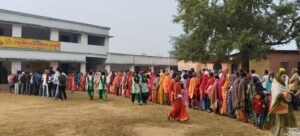SUBHASH MISHRA
Dhanbad, Nov 20: Voters in the Tundi assembly constituency, a known Maoist-affected area in Dhanbad, defied years of fear and intimidation from Naxals, turning out in large numbers to cast their votes during today’s election.
Despite the region’s history of Maoist influence, which has seen violent calls for a boycott in past elections, voters showed unprecedented courage.
According to official figures, voter turnout in Tundi constituency was 48.70 percent till 1 PM whereas it was 31.57% by 11 AM, with long queues of villagers observed at almost all polling booths. The constituency, once considered a Maoist stronghold, had been notorious for its hostile environment, with Naxal groups dictating election boycotts through posters and wall writings on school buildings.
Naxals enforced election boycotts, coercing villagers to refrain from voting in every Panchayat, Assembly and Lok Sabha election.
In the 2005 Lok Sabha elections, the region’s Maoist fears peaked when polling officer Dr. Ajay Kumar Singh was tragically gunned down by Naxal members. However, the situation has since improved, with significant changes in both security arrangements and public attitudes toward elections.
Also Read- 50% Delhi Govt employees to work-from-home as air quality deteriorates

Enhanced security and development fuel voter confidence
The district administration has implemented robust security measures in every election to reassure voters. In the current assembly elections, authorities declared 41 of the 369 polling booths as Naxal-influenced and arranged special security to ensure peaceful voting.
Nayan Ranjan, a voter from Tundi East, expressed that the fear of Naxals has become irrelevant in recent times. He credited improvements in security, road infrastructure, and development for transforming the region. “Awareness for democracy and zeal for voting among voters, especially youth and women, triggered high turnout at booths,” he said.
A record-breaking voter turnout
Ranjan, who has observed elections in the region since 2005, noted that earlier elections saw only 20-30% voter turnout due to Naxal boycott calls. However, on November 20, more than 50% of votes were recorded by noon in the most feared areas such as Palma, Nawada, and Jitpur booths.
A similar high turnout was seen in booths located in the hilly terrain of Topchachi, another Naxal-affected area. This surge in voter participation is largely attributed to a special campaign led by Deputy Commissioner Madhvi Mishra and Senior Superintendent of Police (SSP) HP Janardhan, which worked to alleviate the villagers’ fears.
Also Read- Voting underway for 288 seats of Maharashtra Assembly and 38 seats of Jharkhand
Maoist influence no longer a deterrent
Akshay Kumar, a resident of Topchachi village, emphasized the shift in the region’s attitude towards Naxal influence. “Maoist fear no longer matters for voters of Topchachi, as they were eager to vote and turned up at their concerned booths in the early morning. Especially new voters who have not seen Naxal influence cast their votes fearlessly,” he said.

This growing confidence and determination among voters in Naxal-affected areas like Tundi and Topchachi marks a significant shift in the region’s political landscape.


